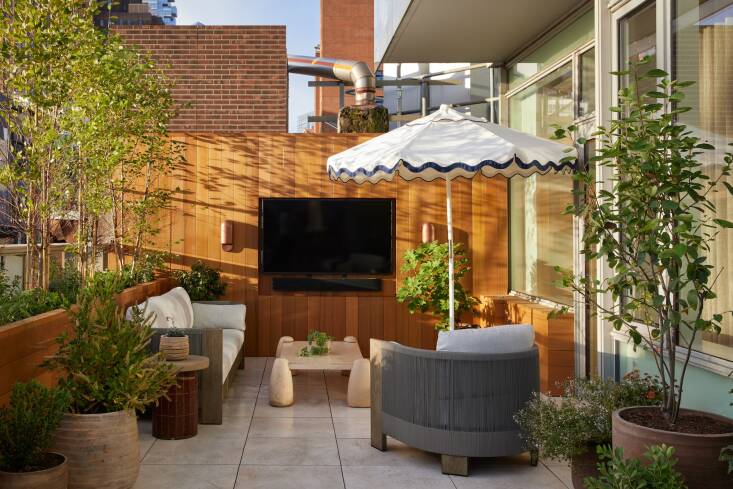When the editor of a literary magazine tapped garden designer Jarema Osofsky to conceive a garden for her SoHo roof terrace, she asked for “a slice of the High Line.” The client imagined her space as a gathering place for friends and a reprieve from the hustle and bustle of the city, says Osofsky, the author of Moon Garden, a book about creating “evening oases.” As the existing 14- x 42-foot terrace was nothing but glass, metal, and personality-less tile, the project would require both clever space planning and a whole lot of plants. Osofsky and Adam Bertulli, her design partner at Dirt Queen NYC, took up the challenge.
Before

Today, when the client steps onto her terrace, she’s greeted with sweeps of pastel-hued native perennials and fragrant shrubs like sweet pepperbush (Clethra alnifolia) planted in a long cedar planter. The space, which once had a runway vibe, is now divided into three distinct “rooms.”
Here’s Osofsky’s advice for how to create an immersive garden in a narrow urban space:
Photography by Brett Wood, courtesy of Dirt Queen NYC.
Assess the environmental conditions.

For any urban garden, Osofsky says it’s key to analyze the conditions. For this terrace, for example, all perennials and shrubs would need to be able to handle the sun. Osofsky and Bertulli also had to consider the kinds of plants, trees especially, that could handle the wind, which led them to use river broaches. “They’re very breezy,” says Osofsky. “They allow the wind to pass through them and they can handle those conditions.”
Source the right planters.

“It was a very narrow space, and so we had to really think about how we could utilize planters and plants,” says Osofsky. Despite the limited space, they went deep with the large cedar planter they designed for the space. “With only 12 inches, you’re very limited in what you can do, but if you have 30-inches, like we do here, you have more room to play with layering.” The wooden planter has a false bottom inside, allowing it to hold less soil, which means less weight.
Use potted plants to define spaces.

In a long narrow space, just a few potted plants can help delineate “rooms” within the space. Osofsky and Bertulli positioned round accent planters to help define and “tuck in” the dining area. A trio of pots separates the reading corner from the dining area, while another grouping separates it from the lounge section.
Look to the interior for inspiration.
The client’s mid-century interior sensibilities served as inspiration for the terrace. “She had a lot of wood pieces indoors that we carried outdoors with the custom bench and custom planters,” explains Osofsky. Likewise, the vintage pieces inside influenced the vintage-looking planters outside.
Create shelter with trees.

While the dining area is planted for an open feeling, Osofsky and Bertulli wanted the living area to feel “intimate and protected.” They achieved this by planting a row of river birches to create a sense of shelter. “The trees will provide shade to the lounge area as they grow taller,” Osofsky notes. They also offer a layer of privacy for the bedroom on the other side of the window.
Use built-ins to maximize space.

“To preserve the limited width we had, we designed a built-in bench that serves as a casual spot to sit and read or relax,” says Osofsky of the corner bench. Note that the seat back is angled to make it more comfortable.
Plan for year-round interest.
Along the apartment’s glass wall, Osofsky and Bertulli planted evergreens in lightweight fiberglass planters, so the client will see green out her window year round. The pentacles from the oak leaf hydrangeas will remain and the grasses and echinacea seed heads will provide further winter interest, explains Osofky.
See also:
- Quick Takes With: Jarema Osofsky and Adam Bertulli
- Before & After: Converting an Unusable, Exposed London Rooftop Into a Tranquil, Private Terrace
- A Study in Serenity: Designer Rose Uniacke’s Tranquil Terrace Garden






Have a Question or Comment About This Post?
Join the conversation